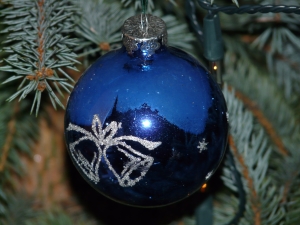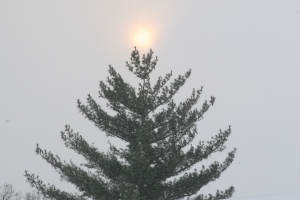9 Symbols of Christmas
Yule–now known as Christmas–once designated a specific period of time, about two months long, from December to January. This period was a time for important feasts, such as the Winter Solstice Festivals. Eventually Yule came to designate a pagan feast lasting twelve days in mid-winter around the time of the Winter Solstice.
The time of Yule historically marked the sun’s rebirth when the longest night of the year (Winter Solstice) gave birth to the beginning of longer days. Norse people considered the sun a giant wheel of fire which rolled away from earth then at Winter Solstice the sun began rolling back closer to earth again. One of the traditions–originally a Nordic tradition–linked to this time period was the yule log.
The yule log symbolized the fire and the light of the sun. Some people thought that the ashes of the yule log would make a home immune to evil spirits and lightning strikes. The logs could be decorated with evergreen–sacred to the Celts as the tree did not “die” and represented the Eternal aspect of the Divine; and dusted with flour to signify triumph, light and life.
–The yule log was actually an entire tree. The tree was chosen and brought into the house with ceremony. Tradition decreed that the log/tree must be harvested from the householder’s land or given as a gift.
–The large end was put in the fireplace with the rest of the tree sticking out into the house. Some people used a log instead of the entire tree. A bit of last year’s tree–having been carefully stored–was used to get the present yule log to burn.
–Different countries used different types of trees for the yule log.
England: oak Scotland: birch
France: cherry Devon and Somerset, UK: large bunch of Ash twigs instead of log
Some parts of Ireland: large candle instead of a log and it’s only lit on New Year’s Eve and Twelfth Night.
In present day: a yule log can be a chocolate sponge cake rolled and layered with cream; chocolate icing and sometimes decorated to look like a bark-covered log.
Or, a piece of log/wood that is planed flat on the bottom and has three holes drilled in it for three candles.
The Norse celebrate the return of the sun–a male deity–with the yule log. Other traditions, such as the Balts, celebrate the return of the sun–a female deity–with many traditions similar to the Norse and involving fire.
According to the Journal of Baltic Tradition, 1994, Winter Solstice celebrations marked the rebirth of the Great Goddess Saule (SOW-lay). Saule means the sun itself. The Great Goddess Saule was regarded as Queen of Heaven and Earth and the Matriarch of the Cosmos.
The Yule Log is not the only tradition to be handed down to modern Christians via pagan rituals.
–During Winter Solstice the Norse Goddess Freya sits at her spinning wheel weaving the fates. The Wheel of Fate symbolizes the cycle of the seasons, the continuity of life–birth, life, death, and rebirth. The wreath once symbolized the Wheel of Fate.
–Trees (now Christmas trees) were brought in to attract and honor tree spirits. The hope was that during the coming warm time the trees would thrive and produce food. Part of attracting these spirits was to sing as a group to guide them to the homes where various foods decorated the tree for them.
–Foods (now Christmas ornaments) decorating indoor trees also symbolized the abundance to come when the sun shed warmth again. 
–The five pointed star was put on the tree to symbolize the five elements: earth, air, water, fire, and spirit.
–Bells were rung to drive away the demons that surfaced during the dark and cold time of the year.
–Candles symbolized fire and the light of the sun.
–Evergreens held power over death and held the power to defeat winter demons and had enough tenacity to urge the coming of the sun.
–Legend says the snowflake was formed from Demeter’s tears when Persephone descended to the Underworld. The flakes have six sides representing the months of her time in the Underworld. Six is also the numerological digit associated with affection. For pagans, snowflakes are the winter symbol for love.
Were you aware of the origins of some of these symbols of Christmas? Do you know any myths attributing different origins to these symbols of Christmas? (Please share!) Leave a comment!
Don’t miss the next post. ENTER your EMAIL and FOLLOW
Want to receive monthly special offers, announcements, stories, and other great content as well as a special bonus just for opting-in? Sign up for the monthly e-newsletter, Just For You (please be aware that blog follow and email newsletter are two different sign ups)
Check out http://facebook.com/AyaWalksfarAuthor for all the latest on upcoming releases; image quotes, and much, much more!
References: Wikipedia Blog.dictionary.com Shootingforthemoon.com/yuletraditionsandsymbols
Dictionary.com Journal of Baltic Tradition, issue #2, 1994
Whychristmas.com/customs/yulelog.shtml Religionfacts.com/neopaganism
Photo credits: all-free-downloads.com Candle: geralt Ornament: Hans Tree with star: Paul Barrows Sea of Christmas lights: Julia


